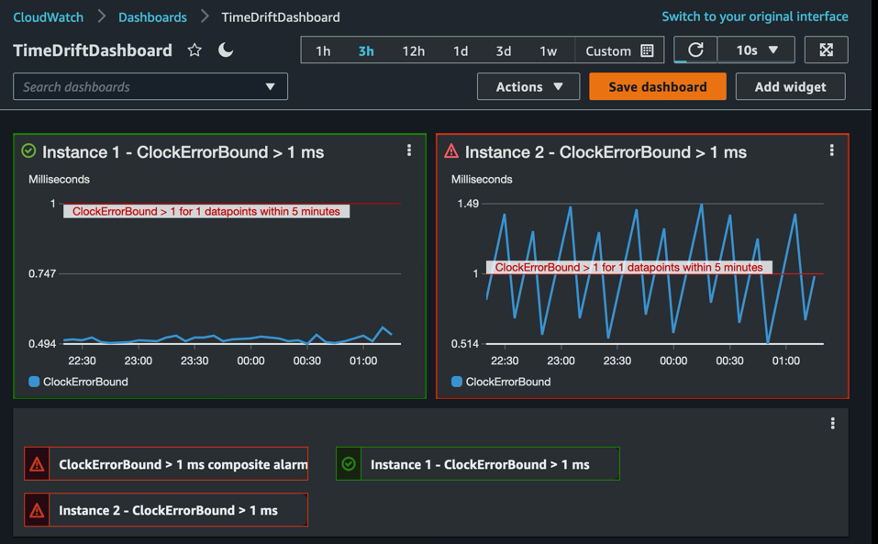AWS Cloud Operations & Migrations Blog
Category: *Post Types
Using environment variables with Amazon CloudWatch Synthetics
With the increase in online traffic, organizations have prioritized the continuous monitoring of their applications so that they can detect issues before they cause widespread problems. Canaries emulate a user flow, making it possible for organizations to proactively catch errors thereby ensuring a good customer experience. Amazon CloudWatch Synthetics allows you to create canaries to […]
Manage Amazon EC2 instance clock accuracy using Amazon Time Sync Service and Amazon CloudWatch – Part 2
In part 1 of this series, I cover important concepts about measuring the accuracy of time on Amazon EC2 instances . I discussed calculating ClockErrorBound (?) and using its value as a range between which system time is accurate. In this part, I walk through the process of using Amazon CloudWatch to measure and monitor […]
Manage Amazon EC2 instance clock accuracy using Amazon Time Sync Service and Amazon CloudWatch – Part 1
This two-part series discusses the measurement and management of time accuracy on Amazon EC2 instances. Part 1 covers the important concepts related to system and reference time. Part 2 covers the mechanism of measure, monitor, and maintain accurate system time on EC2 instances. A large and diverse set of customer workloads depends on the observed […]
Decision-making framework for configuration with AWS AppConfig
In this blog post, we show you how to separate configuration from code, explain the differences between dynamic and static configuration, and help you determine which values to use in your dynamic configuration. We also share processes to keep bloat down in your application configuration. Finally, we introduce you to AWS AppConfig, which allows you […]
Use AWS Lambda and Amazon QuickSight to Build a Dashboard for AWS Health Events in Organizational View
Centralized DevOps teams responsible for the operation of Amazon Web Services (AWS) resources across an organization want to have a consistent approach for receiving and visualizing notifications for AWS Health events. It’s challenging and time-consuming to collect this data from individual accounts through email notifications, by managing separate event data, or even by manually clicking […]
Orchestrating multi-step, custom patch processes using AWS Systems Manager Patch Manager
The ongoing management of operating system and application-level patching is critical for ensuring that your organization’s software is up to date and meets compliance policies. Patching is not always a straightforward process. You often need to orchestrate custom procedures, workflows, and scripts to ensure that applications can be safely stopped, started, and verified during the […]
How to optimize AWS CloudTrail costs by using advanced event selectors
AWS CloudTrail can be used for security, monitoring restricted API calls, notification of threshold breaches, operational issues, filtering mechanisms for isolating data, faster root cause identification, and speedy resolution. CloudTrail can also be used for various compliance and governance controls, by helping you achieve compliance by logging API calls and changes to resources. Event selectors […]
CloudFormation StackSets delegated administration
If you are using AWS CloudFormation StackSets, you are having to manage your stacks from the AWS Organizations management account. According to best practice, the management account should be used only for tasks that require it. Until today, you had to use the management account to manage your AWS CloudFormation stack sets. To help limit […]
Continuous permissions rightsizing to ensure least privileges in AWS using CloudKnox and AWS Config
This blog post was contributed by Kanishk Mahajan, AWS and Maya Neelakandhan, CloudKnox As you migrate your workloads to the cloud or operate your existing workloads in the cloud it would be ideal if every application was deployed with the exact permissions that it required. In practice, however, the effort required to determine the precise […]
Best practices for creating and managing sandbox accounts in AWS
Organizations use multiple environments, each with different security and compliance controls, as part of their deployment pipeline. Following the principle of least privilege, production environments have the most restrictive security and compliance controls. They tightly limit who can access the environment and which actions each user (or principal) can perform. Development and test environments also […]








